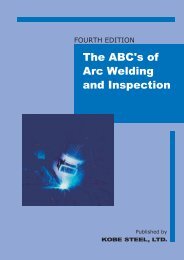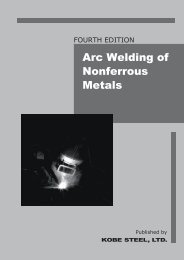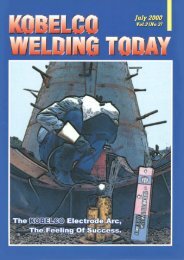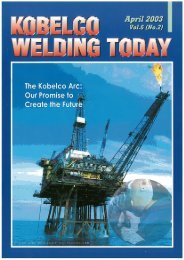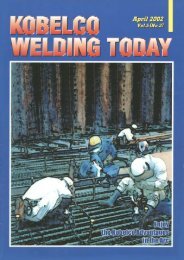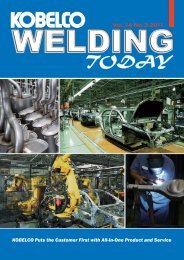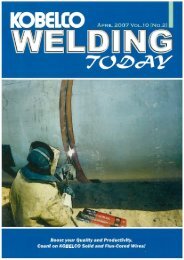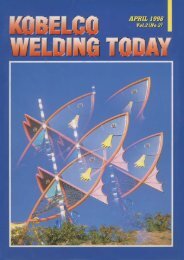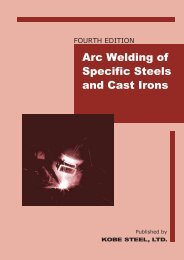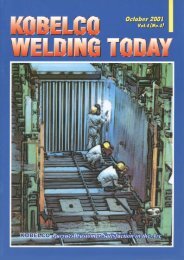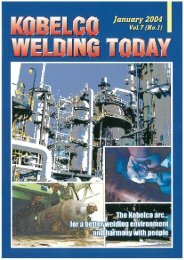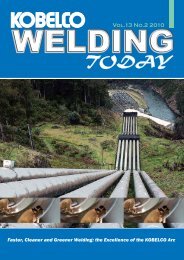Kobelco Welding Today Vol.8 No.4 2005
Kobelco Welding Today Vol.8 No.4 2005
Kobelco Welding Today Vol.8 No.4 2005
You also want an ePaper? Increase the reach of your titles
YUMPU automatically turns print PDFs into web optimized ePapers that Google loves.
Products Spotlight<br />
KOBELCO WELDING TODAY<br />
DC-spec High-Strength 2.25Cr-1Mo-V<br />
Filler Metals for Reactor Vessels:<br />
<br />
Kobe Steel has been supplying overseas markets<br />
with state-of-the-art filler metals for welding highstrength<br />
2.25Cr-1Mo-V steel for reactor vessels<br />
since 1998. They are CMA-106HD for shielded<br />
metal arc welding and PF-500D/US-521HD for<br />
submerged arc welding with the direct current<br />
polarity. These brands have been earning a high<br />
reputation due to their consistent quality in chemical<br />
and mechanical properties, fulfilling the<br />
requirements specified by ASME Boiler and Pressure<br />
Vessel Code Sec. 8 Div. 1 Appendix 31 and<br />
Div. 2 Appendix 26. Recently, however, Kobe<br />
Steel has slightly modified the chemical composition<br />
of these filler metals in order to respond to<br />
more stringent customer requirements: Si+Mn:<br />
1.10% max.; X-bar = (10P+5Sb+4Sn+As)/100: 12<br />
ppm max.; J-factor = (Si+Mn)(P+Sn)×10 4 (%):<br />
120 max. These stricter requirements are to minimize<br />
the temper embrittlement of the weld.<br />
Figure 1 shows temper embrittlement test results<br />
of CMA-106HD and PF-500D/US-521HD weld<br />
metals, respectively. These test results display sufficient<br />
notch toughness in the as-PWHT condition<br />
and after Step-Cooling heat treatment, exhibiting<br />
very low susceptibility to temper embrittlement.<br />
Absorbed energy (J)<br />
200<br />
180<br />
160<br />
140<br />
120<br />
100<br />
80<br />
60<br />
40<br />
PF-500D/US-521HD<br />
vTr55=-38℃<br />
vTr'55=-30℃<br />
ΔvTr55=8℃<br />
vTr55+3ΔvTr55=-14℃<br />
As PWHT<br />
55J<br />
PWHT+SC<br />
20<br />
ΔvTr55<br />
vTr55 vTr'55<br />
0<br />
-60 -50 -40 -30 -20 -10<br />
Testing temperature (deg.C)<br />
Absorbed energy (J)<br />
200<br />
180<br />
160<br />
140<br />
120<br />
100<br />
80<br />
60<br />
vTr55=-58℃<br />
vTr'55=-53℃<br />
ΔvTr55=5℃<br />
vTr55+3ΔvTr55=-40℃<br />
As PWHT<br />
CMA-106HD<br />
PWHT+SC 55J<br />
40<br />
ΔvTr55<br />
20<br />
vTr55<br />
vTr'55<br />
0<br />
-60 -50 -40 -30<br />
Testing temperature (deg.C)<br />
Table 1 shows the chemical and mechanical properties<br />
of CMA-106HD and PF-500D/US-521HD<br />
weld metals in comparison with the ASME Sec. 8<br />
requirements.<br />
Table 1: Typical chemical and mechanical properties of CMA-<br />
106HD and PF-500D/US-521HD weld metals<br />
Properties<br />
CMA-<br />
106HD<br />
PF-500D/<br />
US-521HD<br />
(1) PWHT: 705°C × 28h; (2) PWHT: 705°C × 7h<br />
ASME<br />
Sec.8<br />
C (%) 0.09 0.10 0.05-0.15<br />
Si 0.24 0.14 0.20-0.50<br />
Mn 0.80 0.85 0.50-1.30<br />
P 0.005 0.005 0.015 max.<br />
S 0.003 0.003 0.015 max.<br />
Cr 2.42 2.38 2.00-2.60<br />
Mo 1.02 1.03 0.90-1.20<br />
V 0.28 0.31 0.20-0.40<br />
Nb 0.012 0.013 0.010-0.040<br />
Sb 0.001 0.001 -<br />
Sn 0.002 0.001 -<br />
As 0.003 0.001 -<br />
Si + Mn 1.04 0.99<br />
X-bar 67 6.0 -<br />
J-factor 73 59 -<br />
0.2% OS (MPa) (1) 533 518 415 min.<br />
TS (MPa) (1) 648 634 585-760<br />
El (%) (1) 24 25 18 min.<br />
IV at –18°C (2) Av.151 Av.125 Av. 54 min.<br />
CMA-106HD and PF-500D/US-521HD weld metals<br />
possess fine bainitic microstructures as shown<br />
in Figure 2. This is the reason why the weld metals<br />
exhibit high tensile strength, adequate creep rupture<br />
strength, sufficient impact toughness, and low<br />
susceptibility to temper embrittlement.<br />
CMA-106HD<br />
40μm<br />
PF-500D/US-521HD<br />
40μm<br />
Figure 1: Charpy impact test results of weld metals after<br />
PWHT (705°C × 7h) and PWHT + Step Cooling<br />
Figure 2: Fine bainitic microstructures of CMA-106HD and<br />
PF-500D/US-521HD weld metals after PWHT (705°C × 7h)<br />
1
Preface<br />
KOBELCO WELDING TODAY<br />
Essen Fair Encourages<br />
<strong>Welding</strong> Industries<br />
Booming <strong>Welding</strong><br />
Businesses<br />
It was very hot this summer in Japan. In<br />
these several years the climate in Japan has<br />
become very extreme. In the old days we<br />
sometimes had small thunder storms with<br />
minor showers in the summer season. But<br />
recently there have been much bigger thunder<br />
storms accompanied by heavy showers<br />
such as they often have in Thailand or Singapore.<br />
I guess the climate in Japan is gradually<br />
becoming tropical. Such extreme<br />
weather can also be seen in other places in<br />
the world. The USA has experienced some of<br />
the biggest hurricanes, and there have been<br />
big floods and earth quakes in several countries....<br />
It seems to be impossible for humankind<br />
to stop global warming soon; however,<br />
we should make a concerted effort to<br />
improve the critical situation of the global<br />
environment.<br />
The ESSEN WELDING FAIR was held on<br />
Sep. 12-17 in Essen, Germany, it is the biggest<br />
welding exhibition in the world and is<br />
held every four years. KOBELCO, as one of<br />
many worldwide exhibitors, displayed a lot<br />
of new welding products together with well<br />
known existing products, like DW-series<br />
stainless flux-core wires. During the Fair, we<br />
had a good chance to form closer relations<br />
with our customers and end users through<br />
talking and exchanging technical information<br />
about our welding consumables and their<br />
new projects. We are determined to make<br />
every effort to respond to customer desires<br />
and requirements for both business and technical<br />
matters through our international activities<br />
based on our business slogan of QTQ:<br />
Quality product, Technical service, and<br />
Quick delivery.<br />
How are you doing, dear readers of <strong>Kobelco</strong><br />
<strong>Welding</strong> <strong>Today</strong>? Half a year has passed since<br />
I came to the International Operations<br />
Department. Immediately after taking up my<br />
present post, I visited all the overseas subsidiaries<br />
in order to better understand their<br />
activities. With different sorts of tasks they<br />
must carry out, they all are busy, and I could<br />
see that their businesses seemed to be<br />
expanding at either high or low rates.<br />
As I was in charge of sales in Thailand from<br />
1995 to 2000, visiting the ASEAN countries<br />
made me feel nostalgic about my old days.<br />
But I was surprised by the changes and rapid<br />
growth over the last five years. A big<br />
increase in the production of cars, motorcycles,<br />
and construction machinery by Japanese<br />
manufacturers there has brought about a<br />
remarkable increase of our sales of solid<br />
wires and an expansion of our production<br />
capacity. Having experienced the ASEAN<br />
economic crisis, I felt like I entered another<br />
world on hearing that more than 1.6 million<br />
cars are projected to be produced in Thailand<br />
in 2010.<br />
I am well aware that the establishment of a<br />
stable supply system is a must for us manufacturers<br />
in order to respond to the global<br />
increase in demand, as well as maintenance<br />
of good quality. We have recently increased<br />
the production capacity of flux-cored wires<br />
and solid wires. Still, I am afraid that our<br />
deliveries may be inconveniencing some customers<br />
due to the simultaneous booming of<br />
the world and domestic economies. I apologize<br />
for this inconvenience and should like to<br />
ask for your generous understanding as we<br />
are trying to tackle the problem.<br />
P1<br />
High-tech filler metals for<br />
high strength 2.25Cr-<br />
1Mo-V steel for<br />
desulfurization reactors<br />
P3-7<br />
<strong>Welding</strong> of chemical<br />
tankers, Part 2: essential<br />
factors in welding<br />
procedure controls<br />
P8<br />
Yield point<br />
and<br />
0.2% offset yield strength<br />
Masakazu Tojo<br />
General Manager<br />
International Operations Dept.<br />
<strong>Welding</strong> Company<br />
Kobe Steel, Ltd.<br />
Toshiyuki Okuzumi<br />
General Manager<br />
International Operations Dept.<br />
<strong>Welding</strong> Company<br />
Kobe Steel, Ltd.<br />
P9-10<br />
Messages from<br />
KOBELCO’s global<br />
manufacturing bases<br />
2
Technical Highlight<br />
KOBELCO WELDING TODAY<br />
WELDING<br />
OF<br />
CHEMICAL<br />
TANKERS<br />
Part 2:<br />
Essential Factors in <strong>Welding</strong> Procedure Controls<br />
The cargo tanks and piping systems of chemical<br />
tankers use special grades of austenitic and duplex<br />
stainless steel to resist their corrosive cargos. Such<br />
particular stainless steels require special consideration<br />
and handling to obtain successful welding<br />
results. Following Part 1, “How to Select Stainless<br />
Filler Metals,” Part 2 of this two part series on<br />
welding chemical tankers discusses the essential<br />
factors in welding procedure controls.<br />
Butt joint of solid stainless steels<br />
Transverse bulkheads which section the entire<br />
cargo tank of a chemical tanker into segments<br />
(Figures 1 and 2) use solid austenitic stainless steel<br />
plates of types 316L, 316LN, and 317L.<br />
Longi-bulkhead<br />
Overhead butt joint<br />
Top plate<br />
Trans-bulkhead<br />
Bottom plate<br />
Flat butt joint<br />
Overhead T-joint<br />
Horizontal T-joint<br />
Figure 1: A perspective inside view of a chemical cargo tank<br />
with a transverse bulkhead at the innermost part of the figure<br />
Longi-bulkhead<br />
Horizontal butt joint<br />
Vertical butt joints<br />
No. 1 to 4 cargo tanks<br />
Figure 2: A chemical tanker’s cargo tank sectioned by several<br />
transverse bulkheads<br />
During assembly, plate-to-plate butt joints are<br />
welded in the flat position by submerged arc welding<br />
(SAW). In SAW, double-side single-pass<br />
welding without back gouging is often used for its<br />
higher efficiency. Double-side single-pass SAW,<br />
however, requires more control over welding<br />
parameters to prevent insufficient joint penetration<br />
and excessive melt-through as compared with the<br />
more common multiple-pass welding; therefore,<br />
the proper welding parameters should be determined<br />
through testing in advance. Where excessive<br />
melt-through is likely to occur due to<br />
excessive root opening, shielded metal arc welding<br />
(SMAW) should be used as a supplement before<br />
SAW. As to SAW flux, PFS-1M is more suitable<br />
for double-side single-pass welding because it can<br />
accommodate base metal dilution to a greater<br />
degree than PFS-1.<br />
With 317L stainless steel that contains higher Mo,<br />
high heat input can cause embrittlement of the<br />
reheated part of the weld metal. To overcome this<br />
problem, the heat input and interpass temperature<br />
should be minimized. Table 1 shows the doubleside<br />
single-pass SAW procedure, in which the final<br />
or second pass was welded while the backing or<br />
first pass was water-cooled to prevent reheat<br />
embrittlement of the backing pass weld metal.<br />
3
Technical Highlight<br />
KOBELCO WELDING TODAY<br />
Table 1: Plate-to-plate butt joint of 317L stainless steel by<br />
SAW with PFS-1M/US-317L<br />
Pass (1)<br />
1st pass<br />
(Backing<br />
pass)<br />
2nd pass<br />
(Final<br />
pass)<br />
Wire<br />
Groove preparation:<br />
20<br />
Amperage<br />
(A)<br />
<strong>Welding</strong> conditions<br />
Voltage<br />
(V)<br />
L (AC) 750 34<br />
T (AC) 700 40<br />
L (AC) 870 34<br />
T (AC) 700 42<br />
90°<br />
60°<br />
2nd pass<br />
6<br />
7<br />
7<br />
1st pass<br />
Macrostructure of weld cross section:<br />
Speed<br />
(cm/min)<br />
Heat input<br />
(kJ/cm)<br />
65 49.4<br />
65 54.4<br />
Wire arrangement:<br />
Scott electric<br />
connection<br />
(L)<br />
<strong>Welding</strong><br />
direction<br />
2nd pass<br />
45<br />
5°<br />
(T)<br />
Root face, F (mm)<br />
6<br />
5<br />
4<br />
3<br />
2<br />
DW-317L: 1.2 mmΦ<br />
Amp/Volt: 200A/30V<br />
Base metal: Type 317L<br />
Insufficient extrusion<br />
of reverse bead<br />
12<br />
70°<br />
1<br />
Excessive extrusion<br />
of reverse bead<br />
0<br />
0 1 2 3 4 5 6 7<br />
(b) Completed weld<br />
Root gap, G (mm)<br />
G<br />
F<br />
FBB-3<br />
backing<br />
material<br />
10 mm<br />
1st pass<br />
(1) The 1st or backing pass was water-cooled when the 2nd or final<br />
pass was welded to prevent reheat embrittlement of the 1st pass<br />
weld metal.<br />
An alternative welding process is flux cored arc<br />
welding (FCAW) for joining stainless steel plates,<br />
using flux cored wires. FCAW is more versatile<br />
than SAW because it allows all position welding<br />
and one-side welding using backing materials.<br />
Therefore, FCAW is used not only in plate-to-plate<br />
assembly but also in the block-to-block erection<br />
stage.<br />
One-side FCAW is highly efficient but requires<br />
more control over welding variables to obtain consistent<br />
root pass welds, as compared with ordinary<br />
FCAW. As shown in Figure 3, besides controlling<br />
welding amperage, arc voltage, and welding speed,<br />
this process requires control over the root gap and<br />
root face size of the welding groove to provide<br />
sound root pass welds. A large root gap can cause<br />
excessive extrusion of the reverse side bead,<br />
which, if welding current is too high, is likely to<br />
contain hot cracks. By contrast, excessive root face<br />
causes insufficient extrusion of the reverse side<br />
weld bead, which, if welding current is too low, is<br />
apt to contain insufficient fusion and penetration.<br />
(a) Appropriate root pass<br />
Figure 3: The proper range of root gap and root face to obtain<br />
sound reverse bead appearance and macrostructure in oneside<br />
FCAW with DW-317L and FBB-3 backing material<br />
Butt joint of stainless clad steels<br />
Chemical tankers use stainless clad steels for their<br />
inner bottom plates, longitudinal bulkheads, and<br />
top plates of the cargo tanks (Figure 1). SMAW<br />
and FCAW are commonly used for joining these<br />
components because of superior performance in all<br />
position welding in the assembly and erection<br />
stages.<br />
With either welding process, care must be taken<br />
not to fuse stainless steel clad when welding carbon<br />
steel base metals with carbon steel filler metals.<br />
If stainless steel clad is accidentally fused by<br />
carbon steel filler metal, the weld metal can contain<br />
considerable amounts of Cr and Ni, giving it a<br />
martensitic microstructure that may cause cracks<br />
in the weld metal. To avoid this trouble, carbon<br />
steel welding must be carried out while ensuring a<br />
certain clearance remains between the edge of the<br />
stainless steel clad and the toe of the carbon steel<br />
weld metal as shown in Figure 4.<br />
4
Technical Highlight<br />
KOBELCO WELDING TODAY<br />
Stainless steel clad<br />
Figure 4: A clearance of 1-1.5 mm between stainless steel<br />
clad and carbon steel weld metal can prevent fusion between<br />
stainless steel and carbon steel weld metal.<br />
If the right amount of clearance is difficult to<br />
obtain as in the case of erection welding of cargo<br />
tank top plates (Figure 1), the carbon steel base<br />
metal can be welded with NC-39MoL (E309MoL-<br />
16) or DW-309MoLP (E309LMoT1-1/-4) in the<br />
flat position; the 317L stainless steel clad can then<br />
be welded with NC-317L (E317L-16) in the overhead<br />
position. In this way the problem of<br />
martensite formation and cracking can be eliminated.<br />
Table 2: One-side FCAW of 317L stainless clad steel bottom<br />
plates with FBB-3 backing and DW flux-cored wires<br />
Pass<br />
No.<br />
Filler metal<br />
Size<br />
(mm)<br />
2<br />
1<br />
3<br />
4<br />
Carbon steel base metal<br />
1-1.5 mm<br />
<strong>Welding</strong><br />
position<br />
Carbon steel weld metal<br />
Amp.<br />
(A)<br />
Volt.<br />
(V)<br />
Speed<br />
(cm/min)<br />
1 DW-100 1.2Ø Flat 200 24 15<br />
2 DW-100 1.2Ø Flat 280 30 25<br />
3 DW-309MoL 1.2Ø Flat 180 26 43<br />
4 DW-309MoL 1.2Ø Flat 180 26 30<br />
5 DW-317L 1.2Ø Flat 190 28 14<br />
Butt joint welding of stainless clad steels is often<br />
conducted by FCAW in the flat and horizontal<br />
positions due to its higher welding efficiency.<br />
Table 2 shows how one-side FCAW can join bottom<br />
plates using FBB-3 backing. Table 3 shows<br />
how horizontal FCAW can be used for the longitudinal<br />
bulkhead in the horizontal position.<br />
Table 3: The FCAW procedure for 317L stainless clad steel<br />
longitudinal bulkhead with DW flux-cored wires<br />
Pass<br />
No.<br />
Filler metal<br />
Size<br />
(mm)<br />
<strong>Welding</strong><br />
position<br />
Amp.<br />
(A)<br />
Volt.<br />
(V)<br />
Speed<br />
(cm/min)<br />
1 DW-100 1.2Ø Horizontal 180 24 36<br />
2 DW-100 1.2Ø Horizontal 280 30 54<br />
3 DW-309MoL 1.2Ø Horizontal 180 26 60<br />
4 DW-309MoL 1.2Ø Horizontal 180 26 50<br />
5 DW-317L 1.2Ø Horizontal 180 26 60<br />
6 DW-317L 1.2Ø Horizontal 180 26 50<br />
7 DW-317L 1.2Ø Horizontal 180 26 43<br />
8 DW-100 1.2Ø Horizontal 260 30 75<br />
9 DW-100 1.2Ø Horizontal 220 26 45<br />
10 DW-100 1.2Ø Horizontal 220 26 35<br />
11 DW-100 1.2Ø Horizontal 220 24 34<br />
11<br />
10<br />
9<br />
Welded<br />
after<br />
backgouging<br />
7<br />
4<br />
6<br />
1 2<br />
8<br />
3<br />
5<br />
317L<br />
clad<br />
15°<br />
35°<br />
50°<br />
317L clad<br />
Carbon steel<br />
5<br />
4<br />
2<br />
1<br />
3<br />
12 2.5<br />
Carbon steel<br />
12<br />
(a) Weld pass sequence<br />
(b) Cross section<br />
macrostructure<br />
4<br />
FBB-3<br />
backing<br />
(a) Weld pass sequence<br />
T-joint of stainless clad steels<br />
(b) Cross section macrostructure<br />
In a chemical tanker’s cargo tank, T-joint butt<br />
welding is used mainly to joint the top plate or bottom<br />
plate and longitudinal bulkhead or transverse<br />
bulkhead, respectively as shown in Figure 1. A<br />
typical T-joint butt weld of the bottom plate and<br />
longitudinal bulkhead is shown in Table 4.<br />
5
Technical Highlight<br />
KOBELCO WELDING TODAY<br />
Table 4: The FCAW procedure for 317L stainless clad steel T-<br />
joints between the bottom plate and longitudinal bulkhead<br />
Pass<br />
No.<br />
Filler metal<br />
Size<br />
(mm)<br />
<strong>Welding</strong><br />
position<br />
Amp.<br />
(A)<br />
Volt.<br />
(V)<br />
Speed<br />
(cm/min)<br />
1 DW-100 1.2Ø Horizontal 230 26 36<br />
2 DW-100 1.2Ø Horizontal 280 30 60<br />
3 DW-100 1.2Ø Horizontal 280 30 65<br />
4 DW-309MoL 1.2Ø Horizontal 180 26 32<br />
5 DW-309MoL 1.2Ø Horizontal 180 26 35<br />
6 DW-317L 1.2Ø Horizontal 180 26 25<br />
7 DW-317L 1.2Ø Horizontal 180 26 45<br />
8 DW-317L 1.2Ø Horizontal 180 26 50<br />
9 DW-100 1.2Ø Horizontal 260 29 43<br />
10 DW-100 1.2Ø Horizontal 260 29 48<br />
11 DW-100 1.2Ø Horizontal 260 29 55<br />
Welded<br />
after<br />
backgouging<br />
11<br />
10<br />
Carbon<br />
steel<br />
9 1<br />
8<br />
5 7<br />
3<br />
4<br />
6<br />
2<br />
317L clad<br />
Carbon<br />
steel<br />
(a) Weld pass sequence<br />
45°<br />
317L clad<br />
Figure 5: Stainless steel pipelines mounted on the deck of a<br />
chemical tanker<br />
To ensure the quality of the root pass weld, groove<br />
preparation is essential. Table 5 shows the requirements<br />
of some standards and Kobe Steel’s recommendation<br />
for groove configuration.<br />
Table 5: Proper groove configuration of pipe joints (1)<br />
22 max.<br />
θ<br />
G<br />
F<br />
Bevel angle,<br />
θ (degree)<br />
Root face,<br />
F (mm)<br />
Root gap,<br />
G (mm)<br />
Misalignment,<br />
max. (mm)<br />
ANSI B31.3 37.5±2.5 1.6±0.8 - -<br />
ANSI B31.4<br />
30+5, –0,<br />
37.5±2.5<br />
1.6±0.8 - -<br />
API 1104 - - - 1.59<br />
Kobe Steel’s<br />
recom.<br />
35-40 0.4-2.0 2.5-3.2 0.8<br />
Over 22<br />
10+25, -25°<br />
19<br />
θ<br />
G<br />
F<br />
(1) ANSI B31.3: Chemical plant and petroleum refinery piping<br />
ANSI B31.4: Liquid petroleum transportation piping system<br />
API 1104: Standards for welding pipelines and related facilities<br />
(b) Cross section macrostructure<br />
Pipe welding in chemical tankers<br />
The bridge and cargo tank of chemical tankers are<br />
equipped with the pumping and associated piping<br />
systems (Figure 5) to load and discharge cargos.<br />
Austenitic and duplex stainless steel pipelines for<br />
the piping system are mostly assembled at the factory<br />
and later erected on the ship. For fabricating<br />
pipelines, root pass welding by gas tungsten arc<br />
welding (GTAW) ensures the quality of girth weld<br />
joints.<br />
In root pass welding of austenitic and duplex stainless<br />
steel pipes, back shielding is a must to prevent<br />
oxidation in the reverse side bead as long as solid<br />
filler rods are used. With flux-cored GTAW filler<br />
rods (e.g. TGX-316L), no back shielding is<br />
required because the slag generated during welding<br />
protects the surface of the reverse bead from<br />
the atmosphere. The filler passes are typically<br />
welded by GTAW, SMAW, and FCAW depending<br />
on the wall thickness and diameter of pipes.<br />
Metallurgical considerations<br />
Unlike fully austenitic stainless steel, the matching<br />
weld metal generally contains the proper amount<br />
of ferrite (approx. 3-10FN for 316L and 317L filler<br />
6
Technical Highlight<br />
KOBELCO WELDING TODAY<br />
metals) in the austenite matrix to resist hot crack<br />
and corrosion, and control the mechanical properties.<br />
The ferrite content of weld metal, however,<br />
can vary according to the base metal dilution ratio;<br />
the dilution ratio rises as welding current and<br />
speed increase as shown in Figure 6. With 1.2Ø<br />
flux-cored wire, welding currents should be 150-<br />
200A, and welding speeds should be 20-40 cm/<br />
min; with 1.6Ø, 200-250A, and 20-30 cm/min. In<br />
welding the buffer layer of stainless clad steel<br />
joints, current and speed are essential to control the<br />
ferrite content of austenitic stainless weld metal,<br />
thereby preventing hot cracking.<br />
“Sensitization” is a serious problem encountered in<br />
welding austenitic stainless steel. It is accompanied<br />
by Cr carbide precipitation at the austenite<br />
grain boundaries of the base metal in the heataffected<br />
zone when heated from 500-800°C. The<br />
carbide precipitation depletes corrosion-resistant,<br />
uncombined chromium at the vicinity of the grain<br />
boundaries. The low-chromium regions along the<br />
grain boundaries are thus more susceptible to corrosion.<br />
This phenomenon is called “sensitization,”<br />
and thereby the weld becomes more sensitive to<br />
intergranular corrosion and stress corrosion cracking.<br />
<br />
<br />
<br />
<br />
<br />
<br />
<br />
<br />
<br />
<br />
<br />
<br />
<br />
<br />
<br />
<br />
<br />
<br />
<br />
<br />
<br />
<br />
<br />
<br />
<br />
<br />
To minimize sensitization, the use of low carbon<br />
grades of stainless steel (e.g. 316L, 316LN, and<br />
317L) is essential. In addition, heat input should be<br />
decreased to diminish the width of the heataffected<br />
zone of the weld. Finally, interpass temperatures<br />
should be kept lower than 150°C to cool<br />
the weld faster during welding.<br />
<br />
<br />
<br />
<br />
<br />
<br />
Tips for correct handling of stainless<br />
steels and filler metals<br />
Figure 6: Dilution ratio as functions of welding current and<br />
speed in overlay welding with DW stainless flux-cored wire<br />
As for duplex stainless steel welding, the weld<br />
metal is almost as susceptible to hot cracks as<br />
austenitic stainless weld metal; therefore, welding<br />
current and travel speed must be controlled to prevent<br />
hot cracks as shown in Figure 7.<br />
Travel speed (cm/min)<br />
35<br />
30<br />
25<br />
20<br />
15<br />
No cracking<br />
Figure 7: Hot crack susceptibility of DW-329AP root pass<br />
weld metal in one-side FCAW with FBB-3 backing<br />
5<br />
Cracking<br />
Backing<br />
material<br />
10<br />
140 160 180 200 220 240<br />
<strong>Welding</strong> current (A)<br />
(1) SCRATCHES AND CONTAMINANTS (e.g.<br />
iron powder, spatter, and oil) can damage the passive<br />
coating on the surface of stainless steels,<br />
thereby causing rust and pitting. Several techniques<br />
are available to minimize these problems:<br />
(a) using scratch-free clamping jigs, (b) avoiding<br />
the use of magnet lifting devices, (c) putting<br />
wooden bars between stainless steel plates to prevent<br />
direct plate-to-plate touching, (d) preventing<br />
stainless clad surfaces from facing carbon steel<br />
base metal surfaces, (e) using stainless steel jigs<br />
for bending stainless steel plates, (f) protecting<br />
stainless steel surfaces by applying spatter removal<br />
agents and plywood sheets, and (g) distinguishing<br />
among slag hammers, wire brushes, and grinder<br />
stones used for stainless steels and carbon steels.<br />
(2) MOISTURE CAN CAUSE pit and wormtracking<br />
porosity in the weld metal. To avoid these<br />
problems, once a flux-cored wire or solid wire has<br />
been unpacked, the remaining spool of wire should<br />
be kept in a low humidity room, taking preventive<br />
measures against dew and dust. As for covered<br />
electrodes and SAW fluxes, the absorbed moisture<br />
can be removed by drying them in an electric oven<br />
according to specified temperature and soaking<br />
time.<br />
7
Technical Terms<br />
KOBELCO WELDING TODAY<br />
Yield Point<br />
and<br />
0.2% Offset<br />
Yield Strength<br />
The tensile test can reveal several important engineering<br />
properties of materials. These properties<br />
are strength (yield point, yield strength, and tensile<br />
strength) and ductility (elongation and reduction in<br />
area). The strength and ductility of metals are generally<br />
obtained from a simple uniaxial tensile test<br />
in which a machined specimen is subjected to an<br />
increasing load. The stress (load divided by the<br />
original cross-sectional area, N/mm 2 or MPa) can<br />
be plotted against the strain (elongation divided by<br />
the original gage length, %) as shown in Figure 1.<br />
Tensile strength<br />
Yield point<br />
Tensile strength<br />
Yield strength<br />
Stress<br />
Stress<br />
A<br />
(a) Mild steel<br />
Fracture elongation<br />
A'<br />
(b) Low and high alloy steels<br />
B'<br />
C<br />
B<br />
0.2% offset<br />
Fracture elongation<br />
Fracture<br />
Strain<br />
Fracture<br />
Strain<br />
Figure 1: Stress-strain curves for mild steel and low and high<br />
alloy steel<br />
The stress-strain curve can vary in configuration<br />
according to the properties of the metal tested and<br />
the testing temperature. The stress-strain curve of<br />
mild steel at room temperature, as in Figure 1(a),<br />
displays the point where plastic elongation occurs<br />
with no increase in load. This specific point is<br />
called the “yield point (or upper yield point).”<br />
By contrast, the stress-strain curve of low alloy<br />
steel (e.g. high strength steel and heat-resistant<br />
steel) and high alloy steel (e.g. stainless steel)<br />
exhibits no such a specific yielding point but produces<br />
a smooth curve as shown in Figure 1(b). In<br />
this case, the stress required to produce an offset<br />
(plastic deformation) amount of 0.2 percent is generally<br />
used for the standard strength equivalent to<br />
the yield point, which is called “0.2% offset yield<br />
strength” or “0.2% proof stress.” Both yield point<br />
and 0.2% offset yield strength are often referred<br />
simply to as “yield strength” or “yield stress.”<br />
In Figure 1(b) the straight solid portion (the<br />
straight modulus line) of Line A-A’ traces the<br />
specimen elongation over the original gage length<br />
with increasing stress. This linear proportionality<br />
between stress and strain represents Young’s modulus<br />
(modulus of elasticity) for the metal tested. If<br />
the load on this tension specimen is removed at<br />
any point along the straight modulus line, then the<br />
specimen length will return to its original dimension;<br />
thus absolute elasticity is demonstrated by<br />
the metal. Note Point B on the strain axis, and<br />
draw a line from there to Point B’ parallel to Line<br />
A-A’. The point C, where the 0.2% offset line (B-<br />
B’) intersects the stress-strain curve, is the 0.2%<br />
offset yield strength.<br />
As for weld metal, the characteristic of yielding is<br />
similar to that of the steel materials mentioned<br />
above. That is, filler metals for mild steel (E6019<br />
and E6013) display the yield point on the stressstrain<br />
curve of the weld metal, while filler metals<br />
for high strength, heat-resistant, and stainless steel<br />
exhibit no yield point on their stress-strain curves.<br />
Therefore, in the latter case, 0.2% offset yield<br />
strength is used as shown for individual brand data<br />
in <strong>Kobelco</strong> <strong>Welding</strong> Handbook.<br />
In the design of steel buildings and bridges, yield<br />
strength is used for the standard strength to<br />
develop the allowable stress according to the specified<br />
safety factor. In the case of pressure vessels<br />
the allowable stress is developed based on yield<br />
strength as well as tensile strength according to the<br />
service conditions.<br />
8
Bulletin<br />
KOBELCO WELDING TODAY<br />
Messages from KOBELCO’s Global Manufacturing Bases<br />
The Production Philosophy of KWE<br />
R. Boumans<br />
Production Manager<br />
KWE<br />
Producing stainless steel fluxcored<br />
wires since 1996, the Production<br />
Department of KOBELCO<br />
WELDING OF EUROPE (KWE)<br />
has developed into a steady workforce<br />
of 23 employees including<br />
the maintenance dept.<br />
Because our customers insist on<br />
high quality, fast delivery, and<br />
flexibility, KWE is therefore<br />
implementing modern production<br />
techniques, such as self-controlling<br />
and self-steering production units. This approach asks for<br />
more responsibility and awareness from the workers but<br />
results in their having tighter relationship with their jobs.<br />
However, for any chosen production system to succeed in<br />
ensuring growth, obviously the soil needs to be firm and of<br />
high quality. In reality this means that we first have to make<br />
sure that we have motivated workers who engage in good<br />
and fruitful communication and work in a positive atmosphere.<br />
Often this is underestimated by many companies, and<br />
as a result they have high effort and low results, since nobody<br />
enjoys or is aware of the importance of their jobs. In this part<br />
KWE made a lot of investment.<br />
Finally, to let the process run successfully for the long term,<br />
KWE has set up a system of self-improvement. Themes are<br />
chosen to improve machinery, to continuously update operation<br />
manuals, or to implement automation where ever possible.<br />
We are also providing more frequent education to<br />
workers, and selecting more items for cost reduction.<br />
Max. production; Max. Sales<br />
Hiroyuki Kawasaki<br />
Dpty General Manager<br />
Business Dept.,<br />
KWK<br />
We, at KOBE WELDING OF<br />
KOREA (KWK), manufacture and<br />
sell mainly flux-cored wires for<br />
carbon steel. Our main customers<br />
are big shipbuilders in Korea, who<br />
are enjoying brisk business but<br />
their demand is well over KWK’s<br />
production capacity of 1,200 tons<br />
per month, causing a continuing<br />
tight supply-demand situation.<br />
Though production plans are based<br />
on a projection of sales covering<br />
the months ahead and on firm communication<br />
between the sales and<br />
production sides, we suffer because the production schedule<br />
must often be changed to comply with customer’s demand<br />
for immediate delivery upon receipt of an order.<br />
To overcome this situation, we have proposed and implemented<br />
many improvements across the overall production<br />
system, including improving production speed, reducing the<br />
frequency of and time for production schedule changes, and<br />
enhancing the yield ratio, through integrating the sizes of<br />
hoops and semi-finished products. As a result, we are now<br />
capable of manufacturing 1,500 tons per month, fulfilling<br />
very active demand.<br />
In addition to responding to quantitative demand, we are also<br />
trying to comply with qualitative requests from customers by<br />
expanding the range of technologically dominant products<br />
such as high-quality flux-cored wires for high-speed fillet<br />
welding and low-temperature steel. We will continue to<br />
strive to fulfill our customers' quality and delivery needs<br />
based on consistent quality while pursuing maximum production<br />
and sales.<br />
Ang Sim Guan<br />
Asst. Production Manager<br />
KWS<br />
Being Better!<br />
As you may know, SINGAPORE<br />
is a multi-ethnic country, and<br />
KOBE WELDING SINGAPORE<br />
(KWS) has an identical constitution<br />
as its cornerstone. You can listen<br />
to English and Singlish, as the<br />
main languages along with Chinese,<br />
Hindi and Japanese in our<br />
factory but we all communicate<br />
well and have no problems working<br />
together.<br />
This year, KWS' average production<br />
is 1,200 MT/month, which is double that of five years<br />
ago. Our production combines five brands in 18 sizes produced<br />
by only one production line. We have been working to<br />
improve the production quality in addition to making new<br />
investments in the production facility. Our everlasting challenge<br />
is employing KAIZEN (continual improvement) on the<br />
yield ratio of our products and on reducing excess production<br />
time on our single line that often suffers due to too many<br />
brands/sizes on our menu. Another factor that gets better performance<br />
out of the production line is routine maintenance,<br />
which must be the most important activity performed on the<br />
production facilities in our factory. These machines would<br />
not take a rest by their own will. If you did not take care of<br />
them, the result would be..., you know.<br />
9
Bulletin<br />
KOBELCO WELDING TODAY<br />
I am proud of KWS and my co-workers because we are a<br />
group that will never accept things as they are and keep trying<br />
to reach the next step.<br />
Bright Future of KWT<br />
As sales are growing continuously,<br />
the Manufacturing Department<br />
is becoming busier and busier<br />
day by day at KOBE WELDING<br />
OF TANGSHAN (KWT). As production<br />
volume grows, we are<br />
faced with new tasks to tackle.<br />
How do we secure consistent quality<br />
of products while we increase<br />
production? How do we achieve<br />
Zhou Fang cost reduction to survive in the<br />
Foreman<br />
very competitive market when<br />
Manufacturing Section<br />
Manufacturing Dept. prices of raw and auxiliary materials<br />
are getting higher? How do we<br />
KWT<br />
respond to customers' demands<br />
swiftly? These are the main tasks that are imposed on us.<br />
The staff and workers of the Manufacturing Department are<br />
as young as 22 years in age on average. The cooperation and<br />
efforts of these young people, guided by the General Manager<br />
and Section Manager of the Department, has lessened<br />
various and hitherto-frequent troubles and machine failures<br />
by leaps and bounds. This indicates, I am convinced, that the<br />
assistant manager, foreman and group leaders took pains to<br />
identify the cause of each problem, design countermeasures<br />
and train all the people concerned, which has led the workers<br />
to improve their skills and develop quality consciousness.<br />
We are continuing strenuous efforts, believing that a bright<br />
future is promised for KWT if we set our wisdom to work<br />
and challenge tasks confronting us.<br />
Hello, from the production site!<br />
Nopporn Katepan<br />
QC Senior Manager<br />
TKW/KMWT<br />
In the wet season this year we have<br />
had little rain here in the Bangkok<br />
metropolitan region, and it is not<br />
so hot as usual. By contrast, in the<br />
northern province of Chiangmai,<br />
they had heavy rain causing big<br />
floods. As we have seen on TV<br />
news, foreign countries have also<br />
had extremely strong typhoons and<br />
hurricanes causing terrible floods.<br />
Such abnormal weather has made<br />
us become more aware of global<br />
environmental problems that can<br />
directly affect our daily life.<br />
I joined THAI-KOBE WELDING (TKW) in 1992 right after<br />
graduation and started working for the Maintenance Section.<br />
After five years, in 1997, I was assigned to the Production<br />
Section to take up a new job of controlling the production of<br />
welding electrodes. <strong>Today</strong>, I have got a new mission for quality<br />
and technical control. I am doing my best to achieve consistent<br />
quality of our products and to improve it further to<br />
respond to the users’ desire for better quality.<br />
Our workers have been engaged in long term services, having<br />
sufficient skills for professional production activities.<br />
They also provide very good support to all the quality control<br />
activities including Quality Control Circle, Safety Practice,<br />
five Ss, and ISO 9001:2000 QMS. Now, we are under preparation<br />
for obtaining the certificate of ISO 14001:2004 EMS.<br />
We are determined to provide quality products and services<br />
to satisfy our users. Please visit Thailand and our factory...we<br />
will welcome you.<br />
KOBELCO WELDING TODAY<br />
October <strong>2005</strong>, Vol. 8 (No. 4)<br />
Publisher:<br />
International Operations Dept., <strong>Welding</strong> Company, Kobe Steel, Ltd.<br />
Editor:<br />
KOBELCO WELDING TODAY Editorial Staff<br />
URL: http/www.kobelco.co.jp<br />
E-mail: iod@melts.kobelco.co.jp<br />
10



